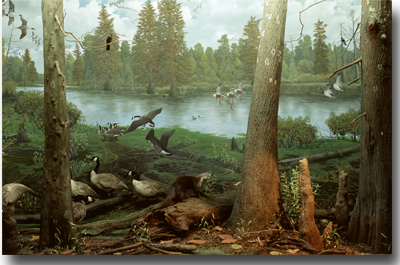
Illinois State Museum
Click on active areas of the image to learn more about sloughs, draining the swamps, and cypress knees.
Southern Swamp
Johnson County, 1673
This scene is a cypress swamp along the upper Cache River in midsummer. Trees of the lowlands and swamp include bald cypress, tupelo, pumpkin ash, swamp red maple, water hickory, water locust, and water elm. The swamp supports a rich variety of aquatic plants. Floating mats of duckweed and mosquito fern make the swamp’s surface appear green or purple in some areas. Duckweed is an important source of food for overwintering waterfowl.
The Cache River Basin is an area of great habitat diversity. Ducks, geese, other birds, aquatic turtles, and mammals such as river otter live in these rich aquatic habitats. The floodplain and upland forests provide habitat for black bear, mountain lion, wapiti (elk), white-tailed deer, gray wolf, wild turkey, ivory-billed woodpecker, passenger pigeon, and Carolina parakeet.
This reconstruction shows a section of Little Black Slough in the Shawnee Hills Division. It is based on Watson Pond in Johnson County, one of the few existing remnants of cypress swamp in the Cache River Valley.
Learn more about swamp forests in the Museum's Forests of Illinois.